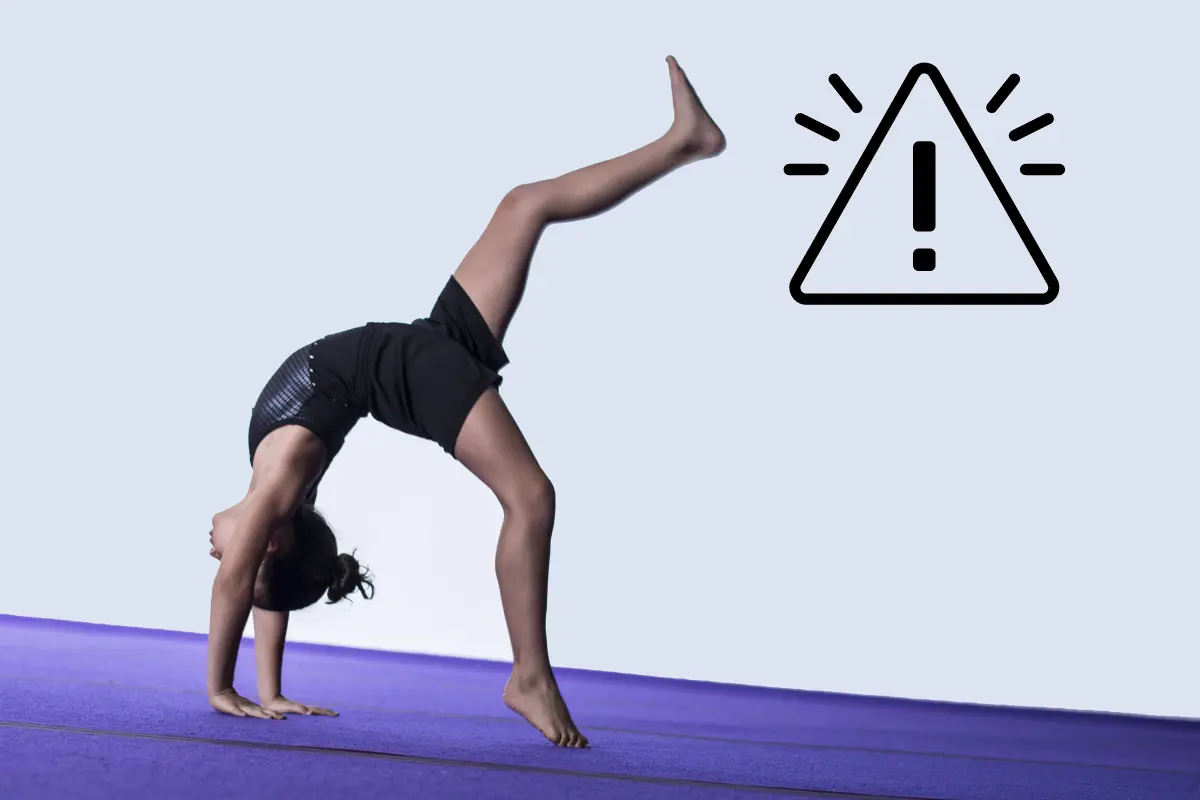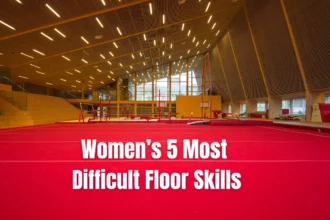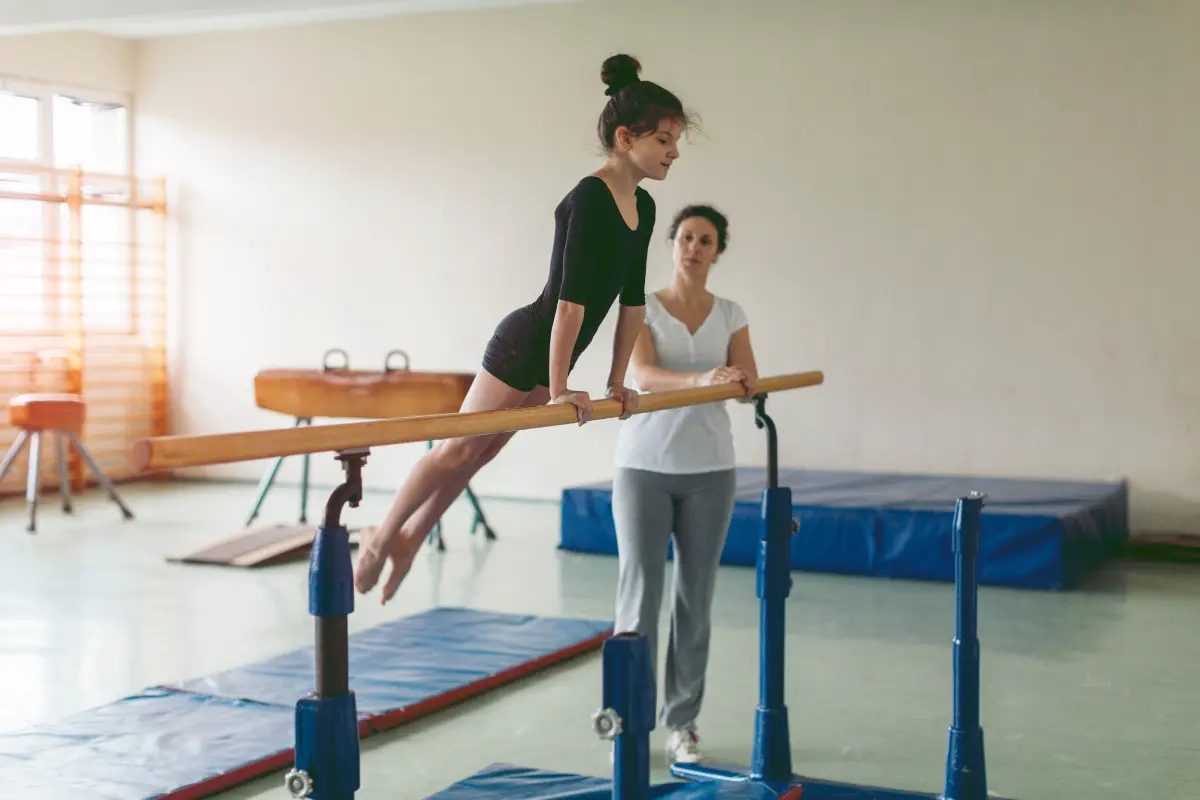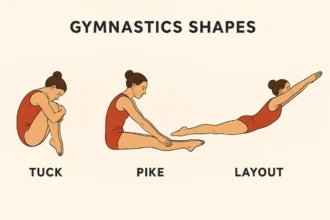A back handspring is a fundamental skill in gymnastics and cheerleading, but it can be quite challenging to master. Today we will show you how to correct five of the most common back-handspring mistakes.
1. Short Back Handspring
A common issue with backhands is making them too short, which limits power and hinders progress to advanced moves like tucks and layouts. It’s crucial to focus on lengthening your back handspring to fix this.
Here are some effective tips:
Setting Goals with Markers
Using markers to set clear hand and foot placement goals can help lengthen your back handspring. Start by marking where your hands should go, and then where your feet should land. This helps gradually increase the length of your back handspring.
How to Do It:
- Perform a Short Back Handspring: Start by doing a short back handspring. Have a partner observe and note where your hands and feet land.
- Set Initial Markers: Place markers slightly beyond your current hand placement.
- Incremental Goals: Set small, achievable markers to maintain motivation and provide a clear path for progress.
Starting Point and Progression
Establish a consistent starting point for your back handspring. Begin on a marked line and gradually move the markers further as you improve. This systematic approach ensures a steady increase in the length of your back handspring.
Full Body Length Goal
A good target is eventually achieving a back handspring that spans your full body length. This indicates a well-executed and powerful back handspring. Once you reach this milestone, refine your technique to stretch it further.
2. Feet Apart
The next common mistake is having your feet apart, which can affect balance and technique. Before even beginning your back handspring, make sure your feet are together.
If you start with your feet apart, it’s unlikely they will come together during the movement. A consistent starting position sets the stage for a better performance.
Here are some tips to ensure your feet stay together:
Using Props for Practice
Props can be incredibly useful for maintaining proper form. Items like scrunchies or stuffed animals can help you keep your feet together.
Stuffed Animals: Place a stuffed teddy bear or another soft toy between your knees. This helps ensure your legs stay together throughout the back handspring. If the toy falls, it indicates your legs have separated.
- Place the stuffed animal between your knees.
- Perform the back handspring, keeping your legs squeezed together to prevent the toy from falling.
- If the toy falls, adjust your technique and try again.
Scrunchies: Another effective tool is a scrunchie around your ankles. This method allows for some flexibility while still providing resistance to keep your feet aligned.
- Put a scrunchie around your ankles.
- Perform the back handspring. The scrunchie will stretch but also pull your feet back together if they start to drift apart.
- Focus on the tension in the scrunchie to help keep your feet aligned.
Benefits of Using Props
Safety: Using soft toys ensures you won’t get hurt if the item falls during the practice.
Flexibility: Scrunchies provide some movement freedom while still encouraging proper form.
3. Bending Arms
Bending your arms in the middle of a back handspring reduces your ability to generate power and makes it difficult to connect to subsequent skills. It’s important to keep your arms straight to maintain form and generate the necessary momentum.
Tips for keeping your arms straight:
1) Practice Hand Hops
Hand hops are a valuable exercise to reinforce the habit of keeping your arms straight. This drill involves hopping on your hands while maintaining straight arms, which helps build the necessary strength and muscle memory.
Regular practice of hand hops will improve your ability to bear weight on your hands without bending your arms, enhancing your overall back handspring technique.
2) Visualize a Toothpick
A useful mental trick is to imagine a toothpick placed at the crook of your elbow. If you bend your arms, the toothpick will poke you. This visualization helps remind you to keep your arms locked out.
Coaches often use this method with their athletes, and it can be particularly effective for younger gymnasts learning to master the skill.
3) Focus on Arm Strength and Flexibility
Improving your arm strength and flexibility can also help you maintain straight arms during a back handspring. Incorporate exercises like push-ups, planks, and tricep dips into your training routine to build the necessary strength.
4. Double Bouncing at the Start
A common mistake in back handsprings is the double bounce at the start. This unnecessary movement reduces power and efficiency. Here’s how to eliminate it and achieve a strong, clean start.
Avoid Double Bounces
Double bouncing before starting a back handspring is a habit that can diminish your power and disrupt your form. While stepping into a back handspring is acceptable in cheerleading, double bouncing is not recommended, especially in gymnastics.
- Focus on One Jump: Multiple bounces take away power and add unnecessary movement. Aim for a single, powerful jump to initiate your back handspring.
Proper Back Handspring Approach
The correct approach for a back handspring involves a specific sequence of movements. By practicing this sequence, you can eliminate double bounces and start with more power.
- Feet Together: Start with your feet together.
- Arms Up: Raise your arms overhead.
- Bend Your Legs: Bend your knees to prepare for the jump.
- Swing Back and Jump: Swing your arms back and jump, initiating the back handspring with one powerful movement.
Practicing the Correct Approach
To eliminate double bounces, practice the correct back handspring approach on soft, supportive surfaces like mats or foam pits.
- Single Jump Practice: Focus on performing the approach with just one jump. Use a soft surface to practice until you’re comfortable with the movement.
- Consistency: Repeatedly practice the single jump approach to build muscle memory and eliminate the habit of double bouncing.
Building Power Without Double Bouncing
Some gymnasts double bounce because they mistakenly believe it gives them more power. It’s important to realize that a single, strong jump provides ample power for a successful back handspring.
- Push Back: Concentrate on pushing back strongly with your legs during the single jump.
- Envision Success: Mentally prepare by visualizing yourself executing a powerful back handspring with a single jump.
5. Lack of Rebound
A rebound is a bounce or jump that happens right after landing a back handspring. It acts as a bridge to connect other skills and helps you maintain momentum and power.
Without a proper rebound, your movements can become sluggish and less dynamic, making it difficult to perform additional skills with fluidity and strength.
Tips for enhancing your rebound:
- Focus on Jumping Out of the Back Handspring
When performing a back handspring, think about jumping out of the landing rather than simply stopping.
Many gymnasts mistake the rebound for just another jump, but it’s about harnessing the power from the landing to propel yourself into the next move. Visualize pushing off the ground with energy and intent.
- Practice on Soft Surfaces
Start by practicing your back handsprings on softer surfaces like tumble tracks or trampolines. These environments provide a forgiving landing that can help you focus on the rebound without fear of injury.
As you become more comfortable, transition to harder surfaces while maintaining the same technique.
- Reduce Delay Between Landing and Rebounding
Aim to minimize the delay between landing your back handspring and executing the rebound. Initially, you may notice a slight pause between the two actions.
Practice shortening this pause until the rebound follows immediately after the back handspring. This continuous movement will help you maintain momentum.
- Utilize Arm and Chest Movements
Your arm and chest positions play a significant role in achieving a high, powerful rebound. Ensure that you pull your arms up and lift your chest as you land.
Keeping your chest down or arms low can hinder your ability to bounce off the ground effectively. By lifting your upper body, you enhance your rebound height and power.
- Consistent Practice
Like any skill, improving your rebound requires consistent practice. Repeat back handsprings with a focus on rebounding until it becomes a natural part of your routine.
The more you practice, the more muscle memory you’ll develop, making it easier to perform rebounds effortlessly.













